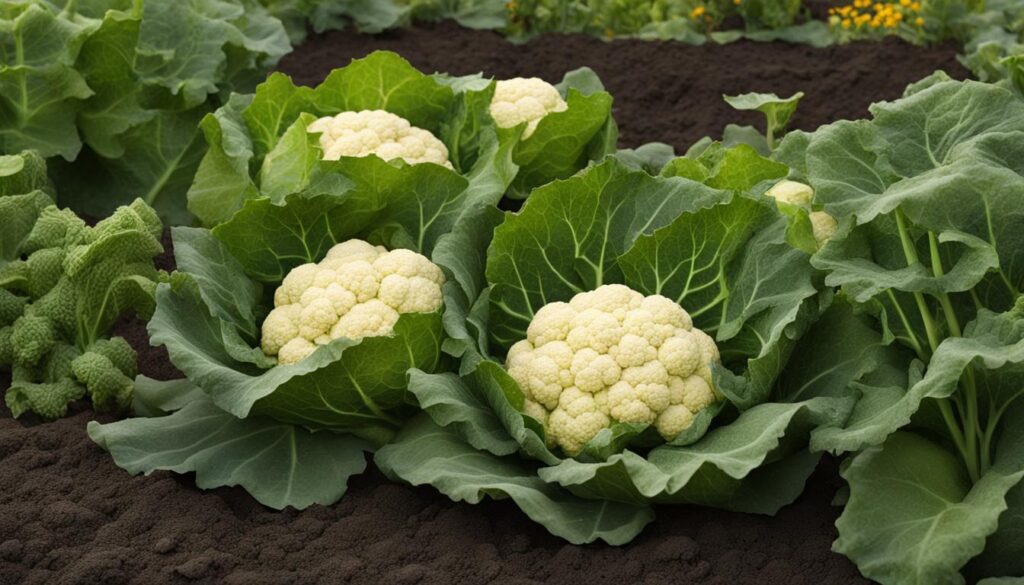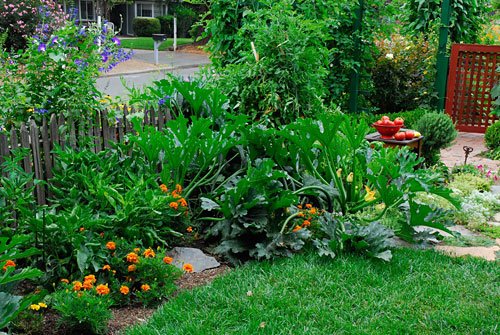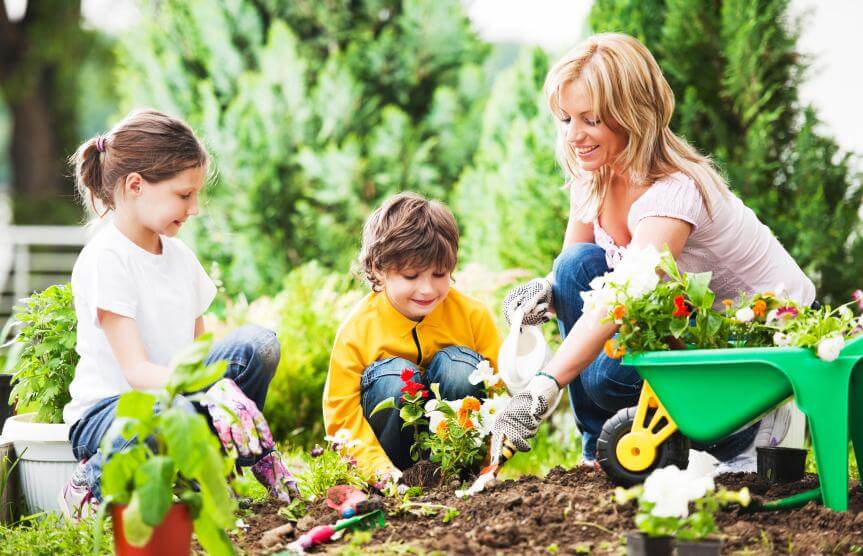Companion planting is a gardening technique that involves growing different plants together for mutual benefit. When it comes to cucumber and cauliflower, companion planting can help maximize your garden yield and create a harmonious ecosystem. By strategically selecting companion plants and understanding their interactions, you can enhance the growth and health of both cucumber and cauliflower plants.
Companion plants for cucumber and cauliflower can provide various benefits, such as pest deterrence, improved soil nutrient retention, and attracting beneficial insects. Some recommended companion plants for cauliflower include beans, celery, onions, sage, thyme, and certain herbs. However, it’s important to avoid planting crops like peas, strawberries, and tomatoes near cauliflower as they can hinder its growth or attract pests.
For successful companion planting, it’s crucial to consider the specific needs of each plant, including water requirements, spacing, and potential conflicts in growth needs. By implementing proper care and attention, you can create an abundant garden where cucumber and cauliflower thrive together.
Post Summary:- Companion planting can maximize the yield and growth of cucumber and cauliflower.
- Recommended companion plants for cauliflower include beans, celery, onions, sage, thyme, and certain herbs.
- Avoid planting peas, strawberries, and tomatoes near cauliflower to prevent hindered growth and pest attraction.
- Consider the specific needs of each plant, including water requirements and spacing, for successful companion planting.
- Regular monitoring for pests, diseases, and nutrient deficiencies is crucial for a thriving cucumber and cauliflower garden.
Understanding Companion Planting for Cauliflower
Companion planting is an effective gardening technique that involves growing different plant species together for their mutual benefit. When it comes to cauliflower, companion planting can offer various advantages, such as improved nutrient uptake, pest deterrence, and enhanced soil quality. One famous example of companion planting is “The Three Sisters,” which combines corn, pole beans, and squash. In the case of cauliflower, there are several companion plants that can contribute to its growth and overall health.
Companion planting with beans, celery, onions, and certain herbs like sage and thyme can benefit cauliflower in multiple ways. Beans, for example, help deter pests like aphids and attract beneficial insects like ladybugs and lacewings. Celery, being a water hog, helps retain soil moisture and leaves more nutrients for the cauliflower. Onions, on the other hand, have natural fungicidal properties and can help protect cauliflower from diseases. Combining these companion plants with cauliflower can create a balanced and thriving garden ecosystem.
“Companion planting can offer various advantages, such as improved nutrient uptake, pest deterrence, and enhanced soil quality.”
Companion planting works by harnessing the natural synergies between different plants. Some plants release chemicals or scents that repel pests, while others attract beneficial insects that help control garden pests. Additionally, certain plants have deep root systems that enhance soil structure and nutrient availability for neighboring plants. By understanding the principles of companion planting and choosing suitable companion plants for cauliflower, gardeners can maximize the growth and yield of their cauliflower crop.
When planning your companion planting garden, remember to consider the specific needs of each plant. Water requirements, sunlight exposure, and growth habits should be taken into account to ensure optimal results. It’s also important to monitor the garden for pest invasions and adjust watering schedules accordingly. With proper care and attention, companion planting can provide a sustainable and enriching way to grow cauliflower and other vegetables in your garden.
Recommended Companion Plants for Cauliflower
When it comes to companion planting with cauliflower, there are several vegetables that can thrive alongside it, providing mutual benefits and maximizing growth. By strategically selecting the right companions, you can create a harmonious garden ecosystem that promotes healthier plants and reduces the risk of pests and diseases. Some recommended companion plants for cauliflower include:
- Beans: Planting beans near cauliflower can have a symbiotic effect. Beans fix nitrogen in the soil, enriching it with this essential nutrient that promotes healthy growth in cauliflower. In return, cauliflower provides a natural trellis for the beans to climb, optimizing space utilization in the garden.
- Celery: Celery is a water-loving plant that can help conserve moisture in the soil, benefiting nearby cauliflower. Its deep root system also helps improve soil structure and nutrient availability, supporting the overall health and growth of cauliflower.
- Onions: Onions can act as a natural pest deterrent for cauliflower. Their strong aroma helps repel pests that are attracted to cauliflower, such as aphids and cabbage worms. Additionally, onions have shallow root systems that do not compete heavily with cauliflower for resources.
- Herbs like sage and thyme: These herbs not only add flavor to your meals but also provide benefits to cauliflower. Sage and thyme are known to attract beneficial insects like bees and butterflies, which can help with pollination and pest control in the garden.
When planning your companion planting garden, consider the specific needs of each plant and ensure adequate spacing to prevent competition for resources. Observing and monitoring your garden regularly can help you make adjustments and ensure the success of your cauliflower and companion plants.
Companion Planting with Cauliflower
| Companion Plants | Benefits |
|---|---|
| Beans | – Fix nitrogen in the soil – Provide a natural trellis for climbing |
| Celery | – Conserve moisture in the soil – Improve soil structure |
| Onions | – Act as a pest deterrent – Shallow root system |
| Herbs (sage, thyme) | – Attract beneficial insects – Aid in pollination and pest control |
These companion plants can enhance the overall health and productivity of your cauliflower crop while creating a diverse and visually appealing garden. Remember to observe and respond to the specific needs of each plant, maintaining proper watering and fertilization schedules. By practicing successful companion planting, you can enjoy a thriving garden and a bountiful harvest of cauliflower and its companions.
Avoiding Incompatible Companion Plants for Cauliflower
While companion planting can be beneficial for cauliflower, it’s important to know which plants to avoid pairing with this vegetable. Some plants can hinder the growth of cauliflower or attract pests that can cause damage. By avoiding these incompatible companion plants, you can ensure the best conditions for your cauliflower crop.
Plants such as peas, strawberries, and tomatoes are not recommended to be planted alongside cauliflower. Peas can compete for nutrients and hinder the growth of cauliflower, while strawberries may attract pests that can damage both crops. Tomatoes are known to attract similar pests as cauliflower, such as aphids and hornworms, leading to increased pest populations and potential crop damage.
In addition to these plants, it’s best to avoid companion planting cauliflower with cucumbers, melons, and potatoes. Cucumbers and melons have different water and nutrient requirements compared to cauliflower, which can lead to uneven growth and nutrient deficiencies. Potatoes are also not suitable companions for cauliflower as they can compete for resources and space in the garden.
By being mindful of these incompatible companion plants, you can create a healthier garden environment for your cauliflower and increase the chances of a successful harvest.

Potential Problems with Incompatible Companion Plants
- Competition for nutrients and resources
- Increased pest populations
- Uneven growth and nutrient deficiencies
Maximizing Growth Through Companion Planting
When it comes to growing cauliflower, companion planting can be a valuable technique for maximizing its growth and overall yield. By carefully selecting companion plants that complement the needs of cauliflower, you can create a thriving garden ecosystem that benefits all the plants involved. Here are some essential tips for successful companion planting with cauliflower:
Choose Compatible Companion Plants
When selecting companion plants for cauliflower, it’s crucial to consider their water and nutrient requirements. Opt for plants that have similar needs to cauliflower, such as beans, celery, onions, sage, and thyme. These plants can help improve soil nutrient retention, deter pests, and create a harmonious growing environment.
Provide Adequate Water and Fertilization
Cauliflower thrives with regular watering, requiring about 1-2 inches of water per week. To ensure optimal growth, make sure your companion plants have similar water requirements. Additionally, fertilize the plants regularly with organic matter or a balanced fertilizer to provide them with the necessary nutrients for healthy development.
Proper Spacing and Avoiding Overcrowding
Spacing your companion plants appropriately is crucial for their growth and development. Avoid overcrowding the plants, as it can lead to competition for resources and hinder their overall productivity. Follow the recommended spacing guidelines for each plant to provide sufficient room for their roots to spread and access nutrients efficiently.

By following these tips and implementing companion planting techniques, you can maximize the growth of your cauliflower and create a thriving garden. Consider the specific needs of each plant, provide adequate water and fertilization, and ensure proper spacing to create an optimal growing environment. Happy gardening!
Additional Considerations for Companion Planting with Cauliflower
When it comes to successfully companion planting with cauliflower, there are a few key tips and precautions to keep in mind. These will help ensure that your cauliflower and its companion plants thrive together, creating a healthy and productive garden ecosystem.
Firstly, it’s important to consider the specific needs of each plant when selecting companion plants for cauliflower. By choosing plants that have similar water requirements, you can avoid over or under-watering certain crops. This will help prevent water stress and promote optimal growth for all plants involved. Regular monitoring of soil moisture levels and adjusting watering schedules accordingly will help maintain the right balance.
Additionally, proper spacing between plants is crucial for successful companion planting. Overcrowding can lead to competition for resources such as sunlight, nutrients, and space, which can negatively impact growth and yield. Be sure to follow the recommended spacing guidelines for each plant to ensure they have enough room to thrive.
Another important consideration is monitoring for pest invasions and taking appropriate action. While companion planting can help deter pests, it’s still essential to stay vigilant. Regularly inspect your garden for signs of pests and take preventive measures such as removing affected leaves or using organic pest control methods if necessary.
Finally, it’s crucial to regularly monitor your garden for any signs of disease or nutrient deficiencies. Early detection and prompt action are key to preventing the spread of diseases and addressing nutrient imbalances. Regularly inspect your plants for any discoloration, wilting, or other abnormal signs and take appropriate measures such as adjusting fertilization or applying organic disease control methods.
Tips for Successful Cauliflower Companion Planting
- Choose companion plants with similar water requirements
- Follow recommended spacing guidelines to avoid overcrowding
- Monitor for pest invasions and take appropriate action
- Regularly inspect plants for signs of disease or nutrient deficiencies
By following these tips and taking the necessary precautions, you can ensure successful companion planting with cauliflower. With proper care and attention, your garden will thrive, providing you with a bountiful harvest of fresh, healthy vegetables.
Can Cauliflower and Celery Be Grown Together Like Cucumber and Cauliflower?
Yes, it is possible to grow cauliflower and celery together. While cucumber and cauliflower may not be ideal companions due to their different growth requirements, cauliflower and celery share similar growing conditions. Both can tolerate cool temperatures and have similar moisture needs, making them suitable to be cultivated side by side in the garden.
Conclusion
Companion planting with cucumber and cauliflower is a smart gardening strategy that can result in a thriving garden filled with delicious vegetables. By carefully selecting compatible companion plants and considering their individual needs, you can create a harmonious garden ecosystem that maximizes yield and promotes plant health.
Remember to pay attention to the water requirements of each plant when planning your companion planting garden. Providing adequate water is essential for both cucumber and cauliflower to thrive. Additionally, choosing companion plants that deter pests and attract beneficial insects can help protect your crops and reduce the need for harsh pesticides.
Proper plant spacing is also crucial for successful companion planting. Be sure to give each plant enough room to grow and avoid overcrowding, as this can lead to competition for resources and hinder overall growth. Regular monitoring of your garden for pest invasions and signs of disease or nutrient deficiencies will allow you to take prompt action and ensure the health of your plants.
With careful planning and attention to detail, you can create a beautiful and productive garden where cucumber and cauliflower grow together in harmony. Enjoy the bountiful harvest of fresh vegetables that your companion planting efforts will yield!
FAQ
What is companion planting?
Companion planting is when different plant species are grown together for their mutual benefit. It can help plants uptake nutrients more efficiently and repel pests or attract beneficial insects.
What are some recommended companion plants for cauliflower?
Some recommended companion plants for cauliflower include beans, celery, onions, sage, thyme, and certain herbs.
Are there any plants that should be avoided as companion plants for cauliflower?
Yes, it’s important to avoid planting certain crops like peas, strawberries, and tomatoes near cauliflower as they can hinder its growth or attract pests.
How can companion planting maximize cauliflower growth?
Companion planting can maximize cauliflower growth by providing benefits such as pest deterrence and improved soil nutrient retention.
What are some additional considerations for successful companion planting with cauliflower?
Some additional considerations include spacing the plants properly, monitoring for pest invasions, adjusting watering schedules based on the needs of each plant, and regularly monitoring the garden for any signs of disease or nutrient deficiencies.









